There are several applications and methods of cooling and
refrigeration using renewable resources such as biomass, solar energy or even basic scientific approaches, such as evaporative cooling mechanisms. At ARTS, we focus on the following applications:
1. Biomass Gasifier Based Refrigeration Systems
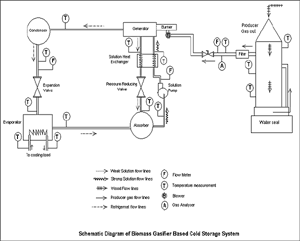
Click on image to enlarge; click 'Back' to return.
Cold storage application at the site of harvest would
immensely benefit the quality and marketability of fruits and vegetables.
Comparative performance studies of biomass gasifier based direct fired vapour
absorption cooling systems and Biomass gasifier operated DG set coupled
conventional vapour compression cooling systems have been made at Anna
University, Chennai, which show that the biomass based direct fired cold
storage systems can be operated at lower cost per TR compared to other modes of
operation.
·
Biomass based DG set operated compression
refrigeration system

Figure 1 shows the schematic diagram of biomass
based DG coupled vapour compression refrigeration system. In the electric mode the gas produced in the
gasifier is utilized in a DG set as a fuel substitute for regular Diesel. The
producer gas from the gasifier is first cleaned completely to remove all traces
of tar and particulate matter. The gas is also cooled to near ambient temperature.
After cleaning and cooling the gas it is used along with Diesel in DG sets as
fuel. The DG set is coupled with an Alternator to produce electric power. The
power produced can be used to operate a VCRS based Cold storage system. The
VCRS is an electrically powered cycle, which relies on the power supplied to
the compressor for its operation. The system consists of four major components
such as Compressor, Condenser, Expansion device and Evaporator. The specific
energy consumption of these plants are : 1.00 to 1.5 kW/TR for the cold room
temperature of 2-4oC.
·
Biomass based direct fired absorption cooling
systems

The thermal mode is relatively
simple; in this mode the producer gas obtained from the gasifier is used as the
energy source for the heat driven Vapor Absorption refrigeration system (VARS).
Figure 2 shows the schematic diagram of biomass based direct fired absorption
cooling system. The producer / wood gas is combusted to provide the necessary
heat energy required by the VARS for producing cold. The components of the VARS
are the generator, absorber, condenser and the evaporator. These are simple and
easy to maintain components. The refrigerant in the VARS is a combination of
two fluids; the refrigerant and the absorbent. The principle of absorption
system is identical with that of the single stage compression system except in
the method by which the pressure of the vapor refrigerant is increased to the
level required for condensation. Instead of compressing the low-pressure
refrigerant vapor, it is first absorbed in an Absorbent (weak solution) in the
absorber. Thus the strong solution from the absorber is pumped to the generator
where using the heat source provided by the combustion of the producer gas, the
refrigerant vapor is driven out into the condenser where the heat is taken away
to condense the vapor into high-pressure liquid. The remaining weak solution
from the generator is expanded to once again enter the absorber. The
high-pressure refrigerant liquid then proceeds as in compression systems to the
evaporator and then comes back to the absorber as low-pressure refrigerant
vapor. Thus the cycle is completed.
2. Pot-in-Pot Vegetable Cooler
The basic motivation for the ‘Pot-in-Pot’ (PiP) vegetable
cooler project is the lack of electricity in rural communities, for there can
be no refrigeration presently without electricity. Even in urban and semi-urban
areas, the power supply is erratic. And in any case, many rural and even the
urban poor cannot afford to buy refrigerators.
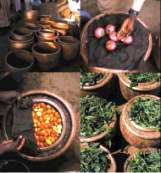
Click on image to enlarge; click 'Back' to return.
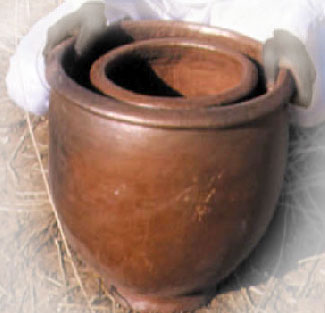
The innovative cooling system in the ‘Pot-in-Pot’ vegetable cooler consists of two earthenware pots of different diameters, one placed inside the other (shown above). The space between the two pots is filled with wet sand or any other medium that can be kept constantly moist, thereby keeping both pots damp. Fruit, vegetables and other items such as potable water are put in the smaller inner pot, which is covered with an appropriate cover that keeps the ‘coolth’ in, whilst permitting the watering process without removal of the top cover. It should be placed in a dry and well-ventilated place for optimum results.
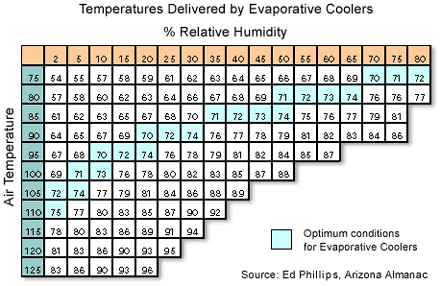
The phenomenon that occurs is based on a simple principle of physics: The water contained in the sand between the two pots evaporates towards the outer surface of the larger pot where the drier outside air is circulating. By virtue of the laws of thermodynamics, the evaporation process automatically causes a drop in temperature of several degrees, cooling the inner container, destroying harmful microorganisms and preserving the perishable foods inside. An added benefit of evaporative cooling is that it works best in the hottest time of the day. As the temperature outside increases as the sun climbs, the humidity normally drops. In the early morning, for example, the temperature is relatively low (of the order of 30ºC), with a relatively high humidity (often in excess of 85%, as in our measurements). By mid-afternoon, when the temperature has climbed, the humidity drops significantly - conditions that make evaporative cooling work more effectively. The above figure shows the range of temperatures delivered by commercial ‘forced convection’ evaporative coolers at various humidities (source: “Ed Phillips, Arizona Almanac”).
The impact of the ‘Pot-in-Pot’ vegetable cooler is perhaps
greatest for women and girls, since they can then sell vegetable produce and
food from their homes and overcome their age-old dependency on their husbands
as the sole providers. The device will liberate girls from having to sell food
on a ‘distress selling’ basis, or to make repeated visits to the markets for
their daily purchases. Instead, they will be free to attend schools or pursue
any activity of their choice.
Farmers will be able to sell on demand rather than 'rush
sell' because of spoilage, and community income levels should rise noticeably.
This will help to stem disease and ultimately contribute to slow the pace of
the rural exodus to cities.
We have made a few samples of PiPs at Santiniketan - based on our preliminary design shown in the figure above. The test results that have been conducted at Calcutta are shown in Annexure 4. The cooling effect is predictably inferior at high humidities (as shown in Fig 2), but our test results show that at the lowest humidity measured at 73%, we recorded the maximum temperature differential of 4.3ºC between the ambient and inside the cooler. Besides, the temperature within the cooler stays reasonably constant, even with fluctuations in the ambient temperature.
Practically - at the height of summer at Santiniketan in May/June this year - we had kept vegetables and fruits which stayed fresh for 10 days with the ‘Vegetable cooler’ out in the sun all day and night and water replenished regularly. On the 11th day, the water supply to the moist earth was stopped, and the perishables perished, forthwith. Unfortunately, detailed scientific experiments complete with wet and dry bulb thermometers and laboratory grade thermometers could not be replicated at Santiniketan, at that formative time. We hope to obtain this crucial data at low humidities during the execution of a DST project to validate the results for this type of static evaporative cooler.
Past experience tells us that socio-technical barriers are a
big obstacle in the large-scale dissemination and education of the villagers
about even simple technologies, such as the PiP. In a similar experiment conducted
by Mohd. Abba in Nigeria, he found that the use of training workshops and the
use of village PR men as "criers” were only moderately successful.
Instead, he discovered that an educational campaign tailored to village life
and the illiterate population is much more successful. His innovative campaign
featured a video-recorded play by local actors who dramatize the benefits of
the device. To take advantage of the progress of technology, we propose to extensively
use Information and Communications Technology to reach our target rural
communities and break down these socio-technical barriers.
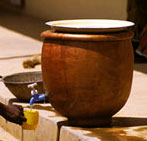
The majority of rural communities will benefit substantially
from the availability of the electricity-free PiP vegetable and water cooler,
especially during the hot and sultry summer months beginning mid-March to July,
when air temperatures are high (in excess of 40ºC) and the humidity is low,
which are the ideal conditions in which the PiP is most effective.